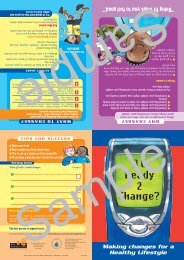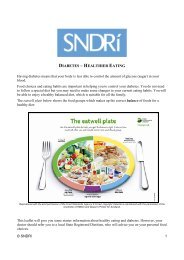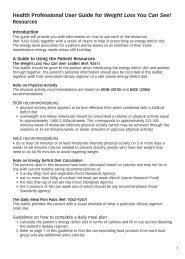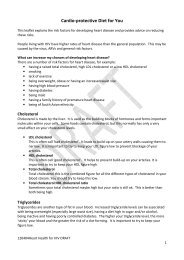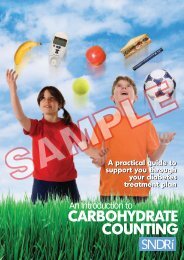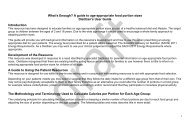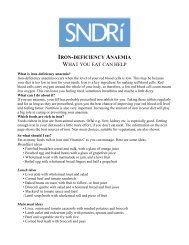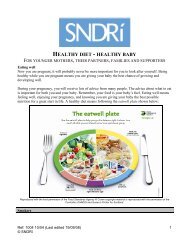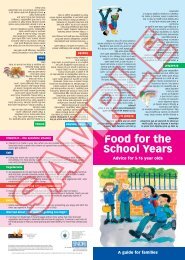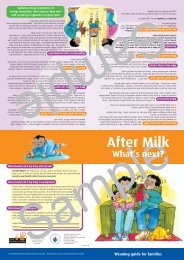Help - My Child Won't Eat Review Draft - NDR-UK
Help - My Child Won't Eat Review Draft - NDR-UK
Help - My Child Won't Eat Review Draft - NDR-UK
You also want an ePaper? Increase the reach of your titles
YUMPU automatically turns print PDFs into web optimized ePapers that Google loves.
<strong>Help</strong>, my child won’t eat!<br />
HELP <strong>My</strong> <strong>Child</strong> Won’t <strong>Eat</strong><br />
A guide for families<br />
Many children go through phases of refusing to eat certain foods or at times refusing to eat anything at all.<br />
This is a normal stage in young children as they become wary of new foods. They need time to learn to like them.<br />
Food refusal is often a way of showing independence and is a normal part of growing up.<br />
Although it is very worrying, children will not harm themselves if they don’t eat enough for a short while. They may<br />
need less to eat than you think.<br />
It may help to discuss the problem with other parents who have already gone through the same situation with their<br />
child.<br />
If the problem shows no sign of improving, or if you are worried about your child’s weight and growth, you can<br />
contact your Health Visitor, GP or dietitian for further advice.<br />
What can I do<br />
Offer regular meals and snacks, as this is better than letting your child ‘pick’ through the whole day. Young children<br />
often need 3 meals and 2-3 nutritious snacks.<br />
Always offer 2 courses at a meal, one savoury and one sweet.<br />
<strong>Eat</strong> at the same time as your child if possible, as he will learn from you. Try and make meals enjoyable social<br />
occasions.<br />
Keep offering your child new foods even if they refuse them at first. Many children will need to taste a new food well<br />
over a dozen times before they accept it. <strong>Eat</strong>ing new foods together with your child is important.<br />
Sit together at the table. Use brightly coloured plates and cups. Present food in fun and attractive ways.<br />
Try and eat in a calm, relaxed area, without the television or toys. <strong>Child</strong>ren are easily distracted!<br />
Try not to rush a meal as your child may be slow to eat. However don’t let meals drag on for too long – half an hour<br />
is about right.<br />
If your child is over 1 year old and still having milk/drinks from a teated bottle, it is important to wean him of this<br />
and encourage drinks from a free flow beaker. This will avoid your child using the bottle as a comfort and having<br />
excess fluids which will interfere with his/her appetite for food.<br />
How can I help<br />
Never force a child to eat. However, it is important that you don’t constantly give into a child’s avoidance of<br />
foods; otherwise they will never try new foods. Try to set boundaries around meal times and try to at least<br />
encourage the child to have a small amount on their lips or on their tongue, or bite size amounts.<br />
Your child is telling you he has had enough when:<br />
04/12/12 Revised 1
• he turns his head away<br />
• he pushes the bowl or plate away or onto the floor!<br />
• he screams or shouts<br />
• he spits food out repeatedly<br />
Although it is a very difficult thing to do, try not to show that you are worried or annoyed by your child not eating. If<br />
he does eat, show him you are pleased (for example, smile and say ‘good boy, well done!’). If he stops eating at a<br />
meal, try once to encourage him to eat a little more. If he doesn’t want anymore, take the food away without any<br />
comment.<br />
It is a good idea for children to use their fingers to play with food. Encourage messy food play. This doesn’t have to<br />
be at meal times, in fact it’s sometimes more relaxed and fun if the food play is outside mealtimes. Do not worry if<br />
they make a mess!<br />
When your child eats well offer a reward such as taking him to the park or spending some special time playing<br />
together.<br />
Which food do I give when<br />
• Give small portions of food at meal times. If these are finished, praise your child and offer more. Do not take<br />
food away and offer a completely different meal if the first one is refused.<br />
• Finger foods are often easier to manage as a child can feed himself. Try sandwiches, sausages, cheese slices,<br />
cream cheese on crackers, potato wedges, fish fingers, vegetable slices and pieces of fruit.<br />
• New foods need to be offered several times before children will even try them. It is a good idea to offer at<br />
least one thing you know your child will eat at each meal.<br />
• Giving children fizzy drinks, squash, milk, crisps, biscuits or cakes can fill them up. This means they may have<br />
a smaller appetite for food at meal times. Avoid giving snacks too close to meal times.<br />
• Milk is a nutritious drink but should not replace meals. Be careful not to let your child drink more than<br />
600ml of milk in total during the day/night.<br />
Sensible <strong>Eat</strong>ing for 1-5 Year Olds<br />
Suggestions to help you:<br />
Breakfast<br />
Small bowl of breakfast cereal with milk or toast with butter/margarine and jam/honey. Cup of milk to drink.<br />
Light Meal<br />
Sandwich in bite size shapes for example ham and tomato, cheese and cucumber, peanut butter or baked beans or<br />
cheese on toast. Small pot of yoghurt/fromage frais/fruit. Cup of water or diluted fruit juice.<br />
Main Meal<br />
Pasta dishes for example macaroni cheese, Spaghetti Bolognese.<br />
Chapatti/rice and curry.<br />
04/12/12 Revised 2
Fish in white, cheese or parsley sauce.<br />
Roast meat or mince for example shepherd’s pie.<br />
Fish fingers/chicken nuggets.<br />
Serve vegetables for example broccoli, fingers of carrot and swede, peas and a scoop of mashed potato.<br />
Fruit segments/slices/shapes.<br />
Cup of water or diluting fruit juice.<br />
Also offer 2-3 small nutritious snacks each day.<br />
Try a variety of foods for a well balanced diet<br />
Food Groups<br />
Milk and dairy foods<br />
Aim for 3 servings a day. These can be given as full-fat milk, cheese, yoghurts, fromage frais, custard and milk<br />
puddings.<br />
Meat, fish, eggs and beans<br />
Offer 2 servings a day. All types of meat and fish are suitable. Many children enjoy minced meat, sausages, chicken,<br />
fish fingers and fish in sauces (try to include an oily fish such as salmon, mackerel or sardines – once or twice a<br />
week). Chick peas, kidney beans and lentils make good casseroles. Hummus, dhal, eggs and baked beans are good<br />
too!<br />
Whole nits, including peanuts, may cause choking in children under the age of five.<br />
Breads, rice, potatoes, pasta<br />
Give these foods at each meal. Most children enjoy eating breakfast cereal and porridge. Other starchy foods to<br />
encourage include bread, potato, chapatti, yam and green bananas, pasta, tinned spaghetti, rice and couscous.<br />
Fruit and vegetables<br />
Offer fruit and vegetables with each meal every day. Try raw and cooked vegetables, raw, cooked, dried or tinned<br />
fruits or pure fruit juice. Encourage 5 small portions each day, but let your child eat as much as they choose to.<br />
Fats and oils<br />
Growing children need some butter/margarine and oils. Adding oils, butter and cream is a good way to increase<br />
calorie intake.<br />
Sugar and salty foods<br />
Foods containing sugar are useful for adding extra calories. Offer them as a pudding and try not give them between<br />
meals. Look after your child’s teeth. Try and avoid giving too many salty snacks and salty processed foods.<br />
Vitamins<br />
<strong>Child</strong>ren under the age of five should have vitamin drops containing vitamins A and D. This is particularly important<br />
for faddy eaters, and all children of Asian, African or middle Eastern descent. Vitamin drops should be available at<br />
04/12/12 Revised 3
your NHS health centre and retail pharmacies. For information on NHS Healthy Start vitamins see<br />
www.healthystart.nhs.uk<br />
Ideas for nutritious snacks<br />
Offer 2 or 3 each day<br />
• Cup of milk with a biscuit, cake or muffin.<br />
• Small bowl of cereal and milk.<br />
• Cheese and crackers.<br />
• Breadsticks, chapatti, pitta bread and cream cheese, peanut butter or hummus.<br />
• Small sandwich.<br />
• Small slice of pizza.<br />
• Apple slice with peanut butter or cream cheese.<br />
• Pancake with spreads such as fruit puree, jam or chocolate spread.<br />
• Milk shake or fruit smoothie made with milk.<br />
• Fruit pieces or vegetable sticks – for extra calories serve with yoghurt, cream cheese, peanut butter or<br />
hummus.<br />
04/12/12 Revised 4




